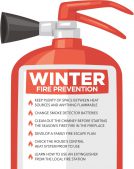 According to the U.S. Fire Administration, more home fires occur in winter than any other time of the year. Cooking results in the largest percentage of house fires, and heating comes in second.
According to the U.S. Fire Administration, more home fires occur in winter than any other time of the year. Cooking results in the largest percentage of house fires, and heating comes in second.
“The majority of (fires) in this day and time are from space heaters or improper heating,” said Citizen Potawatomi Nation Director of Emergency Management and Housekeeping Tim Zientek. “One of the things that is stressed each year is that before you start your furnace in the house, or your central heat and air, that you have your system checked.”
He said keeping everything at least three feet from heating sources is essential to preventing fires. That includes space heaters, fireplaces, radiators and candles. Plugging space heaters directly into wall outlets as opposed to using extension cords and placing backup generators a minimum of 10 feet away from the house help avert fire emergencies.
“If you’re burning wood, make sure you keep the curtains pulled on the fireplace because there are certain types of wood that will throw sparks,” Zientek said.
Other safety precautions include changing air filters and smoke detector batteries, cleaning the chimney to remove buildup, installing and checking carbon monoxide testers, learning how to use a fire extinguisher at the local fire station and developing a family escape plan.
“Draw out a floor plan of your home with every window and every door … then take a line from each room and show how to get out of the house — at least two ways to get out,” Zientek said. “Maybe through a window, maybe down a hall and out of a door, or out of another window, but at least two ways to get out of the house.”
An effective plan also designates a meeting space outside of the home and a family emergency contact. Relatives out of state and away from the dangerous situation are best.
Live Christmas trees present another unique hazard during the winter months. They require a significant amount of care and attention to ensure they remain hydrated. Otherwise, something as simple as the plastic lights wrapped around the branches create enough heat to ignite a flame.
“Even though they’ve been cut off at the ground, they will absorb the water through the trunk of the tree,” Zientek said. “If you fail to do so, the needles will dry out, and then they’ll become like paper.”
Regularly checking and refilling the Christmas tree’s water base can help reduce the potential for a fire.
Zientek’s biggest piece of advice: think ahead.
“Keep an eye on everything,” Zientek said. “Ultimately, you’re responsible for yourself. We encourage you to be responsible for yourself and your family. Prepare yourself for what may be coming.”
